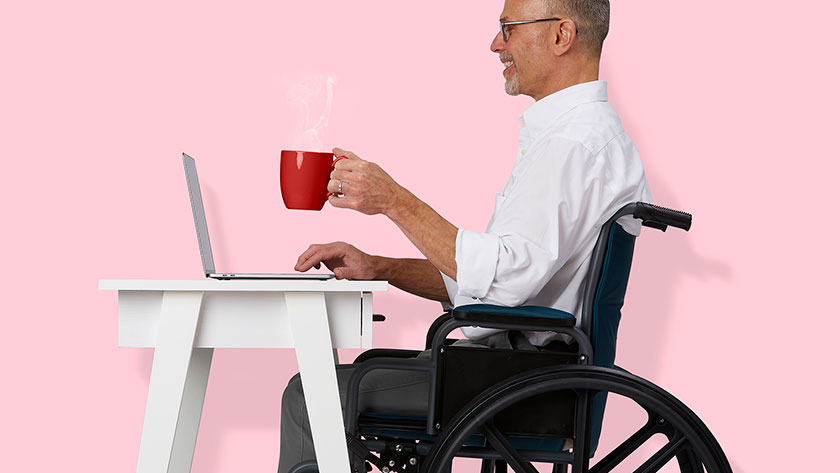Wound care for patients in wheelchairs: Help meet their complex needs and improve their quality of life
Discover effective ways to help patients who use wheelchairs relieve pressure, protect skin and avoid painful injuries By Jan Skwarczyk, PT, CWS, CLT

Each patient comes with unique needs that stem from diverse medical histories, lifestyles and backgrounds. For patients who use wheelchairs, these needs increase in complexity, particularly when it comes to preventing pressure injuries.
Preventing pressure injuries is a common concern with elderly patients in wheelchairs, but it took on a more tragic tone when I met a middle-aged patient who had suffered a serious spinal cord injury after falling down a flight of stairs. He now lives with severely compromised use of his lower extremities and only limited mobility of his upper extremities. Prior to his injury, he had been an active man who owned his own business. Despite his change in circumstance, he was determined to maintain the activities he had always enjoyed.
But the fact was, he had been working long days and neglecting his pressure relief and skin care program, which caused devastating skin breakdown and landed him in my care. To support the success of surgical interventions, we implemented a rigorous pressure relief program, in conjunction with active wound and skin care.
Under pressure
While this patient’s story has stuck with me, there are many others whose experiences are similar—they use a wheelchair, but due to lack of education or lack of adherence to treatment, they don’t properly protect their skin. They’re particularly at risk for skin breakdown and pressure injuries at their sacrum, ischial tuberosities and heels. In addition, many are extremely deconditioned because of advanced age, cardiac issues and other medical comorbidities.
How you can help
Our goal is to provide appropriate ways to relieve pressure and protect their skin. Start with these six considerations to help avoid and treat injuries for patients in wheelchairs:
- The wheelchair itself. Fitting a patient to the right wheelchair and appropriate foam, gel or air pressure-relief cushion is crucial. Doughnut-shaped cushions should not be used.
- The right bed. Patients need to have a pressure relief bed such as an alternating pressure with low air-loss mattress, so that when we tell them to offload completely, they can actually do that. To see how well your facility’s mattresses measure up, request a free mattress assessment.
- Accessories. Using wedges in bed can allow proper positioning to offload existing pressure injuries. Additional pressure-relieving devices can help protect lower limbs.
- Skin cleansing. To help prevent skin breakdown, use a soft cloth to cleanse skin, then dry thoroughly, paying particular attention to skin folds.
- Daily protection. Use an alcohol-free moisturizing cream and silicone-based skin protectant every day. If there’s greater risk of moisture, progress up to a zinc oxide-based product.
- Extra protection. Adhesive soft silicone foam dressings can be used to protect high-risk patients, such as those in the ICU. Multiple advanced wound care dressings are available and can be selected based on evaluation if a wound occurs.

Exercise protection
Physical therapy (PT) can also decrease the risk of pressure injuries for people in wheelchairs. Here are basic techniques I recommend:
Stand or transfer weight.
If able, stand for 30 to 90 seconds every 30 minutes. Transferring out of a wheelchair into bed will also provide full pressure relief from bony prominences. During transfers, ensure that the body is lifted to avoid shear and friction. Equipment such as sliding boards, transfer discs that rotate, transfer/gait belts and lift equipment can help.
Lean side to side.
Lean side to side. Lean to one side until the opposite buttock is lifted off the seat, then repeat on the other side. This should be performed on each side for 30 to 90 seconds every 30 minutes.
Lean forward.
Lean forward—enough to slide a hand under the buttocks—to remove pressure from buttocks. Hold the position for 30 to 90 seconds every 30 minutes. Before performing this exercise, the wheelchair should be locked, with casters facing forward.
Do seated push-ups.
Patients may do these if they are able to extend their elbows and lift their weight for 30 to 90 seconds. These should only be used if they are unable to perform other techniques, as they may harm the rotator cuff from repetitive use.
Note: Before starting a PT program, your patient should be assessed by a healthcare professional to confirm ability and determine which exercises are right for them. If unable to perform independent pressure relief, a power tilt wheelchair is recommended to provide relief mechanically. A tilt angle of between 25 and 65 degrees is recommended; 15 degrees or less does not provide adequate pressure relief.
A team effort
For successful prevention and treatment of pressure injuries for people in wheelchairs, it’s important to have a comprehensive plan and a multidisciplinary team considering all of the variables of risk and aspects of care. Care coordinators, social workers and mental health providers are also important to the team. You can help your patients in wheelchairs beyond wound care by educating them and encouraging adherence to treatment plans.

